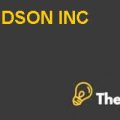KBC Alternative Investment Management: Convertible Bond Arbitrage Executive Summary Case Study Analysis
Do you agree with Joe’s comments about adjusting the delta hedge if Mark is simultaneously hedging the credit risk with CDS? If so, in what direction should he adjust the number of shares sold short? If not, please explain why not.
Yes, I do agree with Joe’s comment on adjusting the delta hedge if Mark is simultaneously hedging the credit risk with credit default swaps, because of the fact that the delta hedging would most likely benefit the traders when they tend to anticipate the strong move in the underlying stock. Additionally the delta hedging would help in protecting the profits from stock or option position in the short term, without unwinding the long term holding. The adjustments in the delta hedge could be made through establishing the delta neutral position by buying shares of the underlying stock.And once the recent rise of the stock ends or the events get changed in favor of the put option position of trader; the trader could then remove the delta hedge. The adjustments should include the delta hedge the position by shorting the shares.
Are the out-of-the-money puts a cheaper form of default protection than the CDS?
Mark could hedge the convertibles’ credit risk through out-of-the-money puts on Duke Energy, as theout-of-the-money puts would most likely lead towards positive payoff in case the company defaults. Additionally, the out-of-the-money puts provides the cheaper protection in credit default as compared to the credit default swap, in a way that the protection buyer has the right to put the assets at the pre-agreed price or at a pre-agreed spread to the credit event protection seller. The motive of the protection buyer is the cheap source of protection against the credit default, which is the similar as purchasing an out of the money input option.(Tavakoli, 2001).
What are the main advantages of hedging credit risk using out-of-the-money puts rather than by shorting shares?
Undoubtedly, the benefits of hedging the credit risk using out-of-the-money puts are more than the benefits of hedging credit risk by shorting shares. One of the greatest advantages of hedging the credit risk using out-of-the-money puts, includes: the protection against limited liability with no margin deposits, lower prices and the potential to benefit from the higher prices of stock. Furthermore, hedging the credit risk using out-of-the-money puts could directly hedge risk. Additionally, the hedging of credit risk using out-of-the-money puts helps in reducing the risk of price reduction, providing leverage in getting credit or loan, establishing price assisting management in production decisions, and buyers might be more accessible, greater flexibility and ease in cancelling commitment as well as former disputes settling procedure. The hedging of credit risk through shorting shares is not optimal decision as there are various risk and threats associated with shorting shares, such as: stock loan fees, margin interest, inherently volatile and opportunity cost.(C. Anderson, 2017).........................................
This is just a sample partical work. Please place the order on the website to get your own originally done case solution.












